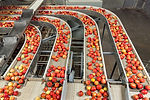Metal Detectors
Introduction
Metal detectors play a critical role in ensuring product safety, protecting equipment, and meeting regulatory requirements.
Regulations mandate that food producers implement effective measures to prevent metal contaminants from entering food products.
How Metal Detectors Work
Metal detectors employ a balanced three-coil system. This system includes a transmitter coil that generates an electromagnetic field, flanked by two receiver coils.
When metal particles pass through the detector, they disrupt the electromagnetic field, causing a detectable voltage change, which signals the presence of metal. To ensure accurate detection, a "metal-free zone" around the detector is necessary, preventing interference from nearby metal structures.

Metal detectors can identify
-
Ferrous metals
-
Non-ferrous metals
-
Stainless-steel
Certain food products, especially those with high moisture, salt, or mineral content, can mimic the signals generated by metal, a phenomenon known as "product effect."
Rejection Mechanisms
Various rejection mechanisms can be used to remove contaminated products from the production line.
Manual rejection
-
Alarm & Stop
Automated rejection
-
Air blowers
-
Push arms
-
Retractable conveyor beds
-
Reversible conveyors.
Combi Metal Detectors/Checkweighers
Metal Detectors can be used in combination with Checkweighers. This will allow the checking of the product weight at the same time. For more information on Checkweighers see our article here.
Key Questions to ask when looking for a used food processing metal detector
Product-Related Questions
-
What types of products will be inspected (dry goods, liquids, wet products, baked goods)?
-
What is the product size and shape?
-
Does the product contain high salt or moisture content?
-
Is there any metal in the packaging?
-
What is the required throughput (product volume per minute)?
Contaminant Detection
-
What types of metal contaminants are most likely to be present (e.g., stainless steel, ferrous, non-ferrous)?
-
What is the minimum size of metal contaminant you need to detect?
-
What level of detection sensitivity is required for your specific product?
-
Do you require multi-frequency technology to detect different types of metal?
Installation-Related Questions
-
Will you need the Metal Detector to be calibrated?
-
Do you need products to run from left to right, or right to left?
-
Where in the production process should the metal detector be installed?
-
Are there any space constraints to consider during installation?
What is your budget?
-
Used Metal Detectors can start in the low thousands and go upward from there, depending on age, condition, and the extra features it comes with.


























